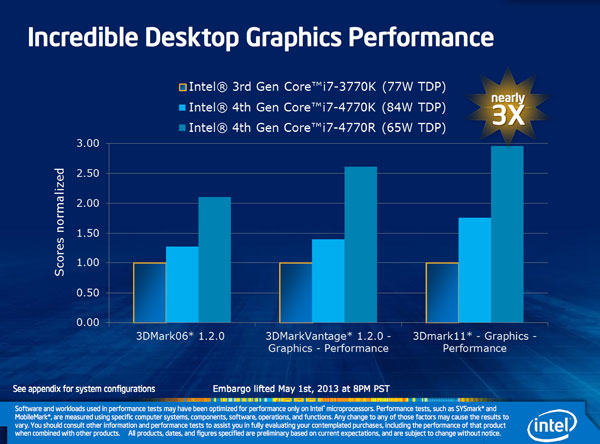 Intel announces what will be the versions of GPU integrated within the different family processors Haswell. Intel Isis is the brand chosen peer identify new proposals for higher-end
Intel announces what will be the versions of GPU integrated within the different family processors Haswell. Intel Isis is the brand chosen peer identify new proposals for higher-end
The market launch of the first Intel Core family-based architecture Haswell is a matter of a few weeks. It will be in early June, to coincide with the 2013 Computex Taipei, which will present the first Intel CPU based on this architecture.
Haswell will continue to use 22-nanometer production technology adopted also by the Ivy Bridge family of Core processors, combining this with a new microarchitecture that will implement some changes to the one currently in use. Specifically, we will see new GPUs, differentiated according to the specific version of CPU proposal. 4 will be the versions of GPU that Intel will offer in conjunction with the CPU Haswell, the positioning is summarized in the following diagram:
The name Intel HD Graphics, which is used for the two versions of GPU HD 2500 and HD 4000 adopted by the family processors Ivy Bridge, will be maintained for 3 families of GPUs combined with Haswell processors. Specifically, GT1, GT2 and GT3 in declination for CPU with 15 Watt TDP will keep the brand HD Graphics, a digital display as a function of increasing processing power made available by the specific CPU.
The two proposals are top of the line instead adopt a new name, that of Intel Iris. For the GPU GT3 combined with processors with TDP of 28 Watt Intel will find the name Iris 5100, while for solutions GT3e the brand will be to Iris Intel Pro 5200.
A choice of this guy wants to separate and lead to better define the potential of these new architectures of GPUs compared to the previous generation, denoting already named as the performance levels provided are of a completely different level than accessible until now with the solutions Intel HD Graphics in commerce.
The GPU GT3e will be combined, as the name suggests, moreover, a kind of eDRAM memory of 128 Mbytes mounted directly on the package. Among Iris Intel Graphics 5100 and Intel HD Graphics 5000 the difference will be represented by the clock frequency, since the underlying architecture identical: this increase was also recorded in the TDP of the processor combined with Intel Graphics Iris 5100, with a value of 28 Watt compared to 15 Watt Model Intel HD Graphics 5000.
Intel has provided some general guidelines on increasing performance achievable with the new GPU, in comparison with the information made available by the current proposals based on Ivy Bridge architecture. With the CPU for the increase Ultrabook systems will be different depending on the type of processor, from a variation of 50% up to about a doubling of the computing power in the light of the results obtained with the benchmark 3DMark11. To be reported as future generations of CPU Haswell Ultrabook systems will have a TDP of 15 Watt; also also find variations of CPU for Ultrabook systems characterized by a TDP of 28 watts, capable of precisely higher computing power for the component integrated GPU.
Similar dynamic applies to the proposals with quad-core architecture: in this case the TDP from the current 45 Watt to 47Watt, with performance increased by over 150%. Recall as with these processors is also possible to select the level of TDP than the default value, of course provided that the cooling system and the power cord are properly sized for this, achieving higher performance levels.

Turning finally to the CPU for desktop systems we highlight in this case too sensitive performance increases, with increases of nearly 200% compared to what has been provided by the HD4000 GPU integrated into the processor Core i7-3770K. In this case increase slightly the TDP; from the current 77 Watt up to 84 Watts, although not fail versions from consuming more content.
It 'clear that the goal of this new generation of Intel integrated GPU in its Core is to make available to end-customers and partners systems manufacturers processing power such as to give up a mid-range discrete GPU from install on your system. On paper, the evolution from the hardware point of view are therefore very present but remains to be seen to what extent this will be realized in a more efficient management of software component has always been the real limit of Intel in the development of their GPU architectures.




.jpg)



.jpg)

.jpg)
.jpg)


Post a Comment